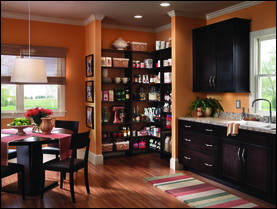 Whether or not you have a dedicated pantry, ClosetMaid MasterSuite (seen here in Chocolate Pear) can make smart use of your space with a style that will complement your kitchen. Photo courtesy of ClosetMaid. |
A pantry can help consolidate the cans, boxes, and appliances cluttering your counters and cabinets by storing them neatly in one convenient place. "If you’re an organized person, you’ll really love a pantry," says Joni Zimmerman, president of Design Solutions Inc. in Annapolis, Md.
But before you start planning your pantry, decide what you want to store. That determines how much space you’ll need and how to configure it. You may only need storage for canned and dry food, or a place to put potatoes, kitchen appliances, pots, china, paper goods, household chemicals, dog food, kitty litter, a ladder, brooms, and the recycling. "The key is knowing what you’re designing for and maximizing the space," says Lori Carroll, president of Lori Carroll & Associates in Tucson, Ariz.
Pantry Types
A pantry should be close by and accessible so that it’s convenient to use. If you have lots of space, consider a walk-in. A walk-in pantry can be a separate room with a door, or an open area off the kitchen. You can put anything in it from shelving and cabinets to an extra refrigerator or freezer. You can build a baking center into your pantry with a countertop, electrical outlets, and shelves for appliances, and bins for flour and sugar.
If your space is limited, you still have lots of choices. Remember that a space six inches deep is large enough to store many cans and boxes. You can attach a cabinet or shelves along an open wall, build a long, 12-inch-deep pantry in the hall, or convert an unused closet by removing the door and adding shelves or cabinets. You can also buy a freestanding pantry unit and squeeze it into a corner. You might also consider a mix of options.
Consider expanding existing cabinetry to make a pantry. One popular option is a vertical pull-out pantry 12 to15 inches wide and 84 to 96 inches high with shallow rows of shelves on both sides. "Pullouts are incredibly efficient," says Tricia Bayer, co-owner of Belle Kitchen in Minneapolis, Minn. "It’s a tremendous amount of storage in a very narrow space." There are also pull-outs with horizontal shelves and fold-out pantries with shelving units that swing out. A base cabinet can also be converted into a pantry by installing roll-out shelves.
 A pantry can be built-in and have baking counters, appliance garages, storage, a sink, recycling, a refrigerator, and any manner of cabinetry. |
A pantry should be attractive and match the style of the kitchen. If it’s messy, consider using doors. Be creative. "A pantry door can be something a little offbeat that brings interest to a kitchen," Zimmerman says. "Pantries can be so versatile."
Pantry Accessories
Accessories of all types, sizes, and materials are available to help you make the most of every inch of space in your pantry. There are shelves that pull out, roll out, or swing out, but solid shelves are best because items tend to tip over on wire shelves. There are also vertical dividers, baskets, drawers, spice racks, wine racks, stemware holders, platter and cookie-sheet organizers, hooks, stackable bins, accessories to hang on the back of the door, and numerous units designed specifically to fit in your corners. "With interior accessories there are so many good things out there to help maximize your storage," Bayer says.
Pantry shelves and accessories should be adjustable. It’s important to be able to move bins and baskets around and make shelves of varying heights and depths to accommodate items of different sizes. An adjustable pantry can reconfigure itself as the family’s needs change and is an asset when selling your home.
For a pantry to be efficient, everything must be visible and accessible. Don’t make shelves too deep, or you’ll lose items in the back. For shelves deeper than 14 inches, it’s best to use roll-outs. Also, make sure to install good lighting.
Pantry Organization
It’s best to separate things in your pantry by category: canned goods, cereals, pasta, baking good, appliances, etc. Put often-used items where you can reach them without bending or climbing and those that you rarely use on higher shelves. Heavy items should be located on the bottom. Tuck flat things like soda cases in the few inches left under the bottom shelf. "People don’t really think about accessibility as much as they should," says Tom Ferri, owner of Tom Ferri’s Closet Make-Overs in Export, Pa. "You want to put the things you use the most at the levels where they’re easier to reach and the stuff you don’t use in the harder-to-reach places."
Every few months, take the time to tidy up your pantry. That will help you optimize your pantry space and keep tabs on supplies.
Credit: Renovate Your World




























